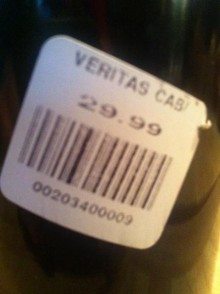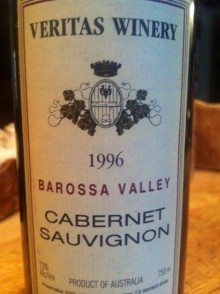 How does Barossa cabernet sauvignon age? Here’s some insight based on only one example; $29.99 Rolf Binder’s 1996 Cabernet Sauvignon from his Veritas Winery. While the question deserves more exhaustive tasting with full sets of wines, this was a telling experiment using just one cabernet from a top Barossa winery.
How does Barossa cabernet sauvignon age? Here’s some insight based on only one example; $29.99 Rolf Binder’s 1996 Cabernet Sauvignon from his Veritas Winery. While the question deserves more exhaustive tasting with full sets of wines, this was a telling experiment using just one cabernet from a top Barossa winery.
WINE BLOGGING WEDNESDAY 76: BAROSSA BOOMERANG
While admittedly contributing, in my own small way, to the statistical decline of Australian wine retail sales and imports in the US, I simultaneously ignored a small section of mid 1990’s Australian cabernet tucked away, out of clear sight lines, in my own cellar. I was on the hunt for alternative sources of value in cabernet during the 1990’s as California producers consistently accelerated price points despite inconsistent product quality. Probably symptomatic of the export problems Barossa experienced between 2008-2010, the young cabernets did not figure into my palate; excessively ripe and hot product fell short or hid the elegance, restraint, and nuance I was trained to appreciate by Bordeaux and a smattering of California cabernet producers. I knew others bowed appreciatively to the Aussie style. Maybe aging would work for me?
 I found this bottle of 1996 Veritas Cabernet searching around the cellar in advance of Wine Blogging Wednesday #76- The Barossa Boomerang. I planned a longer aging experiment, but needed something under $30, with age, and a variety other than Shiraz to drink now. The Veritas Winery has a history of making wines with major league expression since 1955, producing fortified wines and old vine mataro at its inception. While I also found palate alignment challenges with Veritas’ full throttle Hanish Shiraz that made the winery famous with Robert Parker’s followers, I loved Veritas’ late ’90s Clement wines produced from old vine Grenache and Mourvedre. They were massive and tannic, but had nuance and interesting character underneath it all. So maybe the 15 years in bottle would show that years ago the cabernet character was simply overrun by youthful ripeness and tannin?
I found this bottle of 1996 Veritas Cabernet searching around the cellar in advance of Wine Blogging Wednesday #76- The Barossa Boomerang. I planned a longer aging experiment, but needed something under $30, with age, and a variety other than Shiraz to drink now. The Veritas Winery has a history of making wines with major league expression since 1955, producing fortified wines and old vine mataro at its inception. While I also found palate alignment challenges with Veritas’ full throttle Hanish Shiraz that made the winery famous with Robert Parker’s followers, I loved Veritas’ late ’90s Clement wines produced from old vine Grenache and Mourvedre. They were massive and tannic, but had nuance and interesting character underneath it all. So maybe the 15 years in bottle would show that years ago the cabernet character was simply overrun by youthful ripeness and tannin?
Curiously, after a decade and a half in its cold and dark bottle, fresh lively fruit is still dominant on the nose; an amalgam of cassis, bright red berry, and deep black cherry. It’s all somewhat more discernable now. A little toast and fresh pine aromas show up, while the secondary aromas I want more of are either just getting their legs or subdued by the wine’s persistent fruit driven rambunctiousness. It is a wine you will get more than less from. It’s up to you and your palate if “less is more” or “more is better”.
 At 13% alcohol, the wine shows a little more heat than I would prefer, but the fruit has rounded nicely and some, not most, of the tannins have resolved. With an ongoing stiff backbone, it is clear that the age has tamed the wine without changing its overall personality too much. Silkier fruit and a more elegant mouthfeel have turned the wine from monster to drinkable and left it with a medium finish. The color was still a clean deep dark red with maybe amber touches at the edge. My guess is it’s a good thing there is so much living fruit to handle the very present tannins over the next decade or even two. But the kind of integration and secondary aromas and flavors you might expect from cabernet grown in Bordeaux and California after fifteen years of bottle age remained elusive; for that I am disappointed.
At 13% alcohol, the wine shows a little more heat than I would prefer, but the fruit has rounded nicely and some, not most, of the tannins have resolved. With an ongoing stiff backbone, it is clear that the age has tamed the wine without changing its overall personality too much. Silkier fruit and a more elegant mouthfeel have turned the wine from monster to drinkable and left it with a medium finish. The color was still a clean deep dark red with maybe amber touches at the edge. My guess is it’s a good thing there is so much living fruit to handle the very present tannins over the next decade or even two. But the kind of integration and secondary aromas and flavors you might expect from cabernet grown in Bordeaux and California after fifteen years of bottle age remained elusive; for that I am disappointed.
The current day version of 1996 Veritas cabernet showed progress since the youthful version that overwhelmed in less pleasant ways. Understanding that my experiment was only one wine, vintage, and producer, these wines seem to tame themselves without integrating or resolving themselves into a style that is reminiscent of other new and old world cabernet producing regions. It still reminded me of the young Barossa cabs I had experimented with 15-20 years ago. Heat, alcohol, ripe desert-appropriate fruit, underbrush or pine, and bold extraction seem to be characteristic of the Barossa style and terroir. The fact is, a lot of people will fall over themselves for just that kind of wine.
Rolf Binder’s Veritas Winery is a force to be reckoned with in Barossa. Just try the old vine grenache and mourvedre based wines and see what I mean. If you like the Aussie style cabernet, I am certain that Binder’s version is worth a go….after aging!